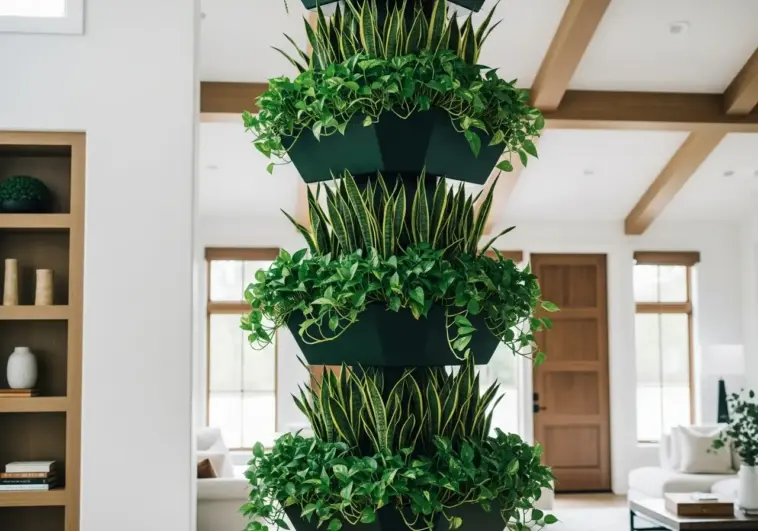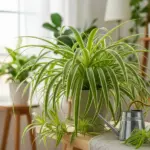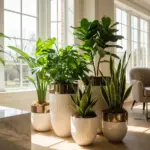Did you know that interior designers charge an average of $2,500 just for plant wall consultations? It’s true!
While scrolling through Pinterest last week, I stumbled upon some jaw-dropping vertical gardens that made my tiny New York apartment feel incredibly boring. But here’s the thing – those “exclusive” designer secrets aren’t actually that exclusive at all.
As someone who’s transformed three different apartments with stunning plant walls (and saved thousands in the process), I’m about to spill the tea on seven game-changing ideas that top designers have been gatekeeping.
These aren’t your basic pothos-on-a-trellis situations. We’re talking about show-stopping, Instagram-worthy installations that’ll have your guests asking for your designer’s contact info!
Ready to create a living masterpiece that rivals those $10,000 designer installations? Let’s dive into these closely-guarded secrets that’ll transform your space without breaking the bank.
1. The Floating Moss Wall Masterpiece

Okay, let me tell you about the time I completely messed up my first moss wall project. I was so excited after seeing this gorgeous preserved moss installation at a fancy Manhattan restaurant that I rushed home and basically glued random moss to my bedroom wall.
What a disaster that was.
The moss started falling off within two weeks, and I had these weird brown patches all over my white paint. But here’s the thing – that epic fail taught me everything I needed to know about creating floating moss walls that actually last.
My Step-by-Step Process (After Learning the Hard Way)
First things first, you need to understand that preserved moss is completely different from live moss. I learned this the expensive way when I spent $200 on live moss thinking it would work indoors.
Start with a sturdy backing material. I use 1/2-inch plywood cut to whatever size you want your moss wall art to be. Sand it smooth because trust me, splinters and moss don’t mix well.
Apply a thin layer of spray adhesive – and I mean thin. My first attempt looked like I dunked the whole thing in glue.
Work in small sections, about 12 inches at a time. Press the preserved moss gently but firmly, overlapping edges slightly to avoid gaps.
The Best Moss Types I’ve Actually Tested
After trying probably fifteen different varieties, here are my go-to options for different lighting conditions.
Reindeer moss works amazing in low-light areas like hallways or bathrooms without windows. It stays that gorgeous sage green color even in dim spaces.
For bright, indirect light spots, sheet moss is your best friend. It has this incredible texture that catches light beautifully.
Here’s something most tutorials won’t tell you – avoid cushion moss if you have pets. My cat somehow managed to pull chunks of it off the wall, and it was a nightmare to clean up.
Maintenance That Actually Works
The beauty of preserved moss walls is they’re basically maintenance-free once installed properly. No watering, no fertilizing, no worrying about plant diseases.
Dust them gently with a soft brush every few months. I use an old makeup brush – works perfectly.
Keep them away from direct sunlight and high humidity areas. My bathroom moss wall started getting weird and musty after about six months.
Real Cost Breakdown (Because I Track Everything)
Here’s what I spent on my 4×6 foot living wall installation:
- Preserved moss: $180
- Plywood backing: $25
- Spray adhesive: $15
- Mounting hardware: $20
Total: $240 for something a designer quoted me $2,800 for. I’m not even kidding about that quote.
Perfect Placement for Small Spaces
Vertical garden design in tiny apartments is all about creating focal points without overwhelming the space.
Behind your bed as a green wall headboard – this completely transformed my studio apartment. It adds so much visual interest without taking up floor space.
In narrow hallways where you can’t fit furniture anyway. My 3-foot wide hallway looks twice as wide now with the moss wall drawing your eye upward.
Pro tip from my mistakes – don’t put it directly across from a window. The contrast makes it look darker than it actually is.
The moss wall decor trend isn’t going anywhere, and honestly, once you see how easy this is, you’ll want to put preserved moss everywhere.
Ready to discover the next game-changing secret? Click the button below to learn about creating your own hydroponic herb garden wall that’ll have your kitchen looking like a high-end restaurant – and actually provide fresh herbs for cooking!










GIPHY App Key not set. Please check settings